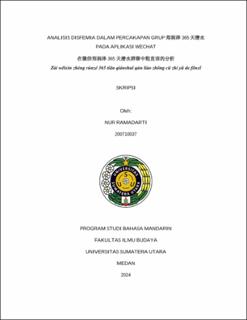Analisis Disfemia dalam Percakapan Grup 郑润泽365天潜水 pada Aplikasi Wechat 在微信郑润泽365 天潜水群聊中粗直语的分析 Zài wēixìn zhèng rùnzé 365 tiān qiánshuǐ qún liáo zhōng cū zhí yǔ de fēnxī
Analysis of Dysfemism in the 郑润泽365天潜水"Group Conversation on Wechat 在微信郑润泽365 天潜水群聊中粗直语的分析 Zài wēixìn zhèng rùnzé 365 tiān qiánshuǐ qún liáo zhōng cū zhí yǔ de fēnxī

Date
2024Author
Ramadarti, Nur
Advisor(s)
Nasution, Vivi Adryani
Jessy
Metadata
Show full item recordAbstract
This research aims to describe the forms and types of dysphemism in the group conversation 郑润泽365天潜水(Zhèng rùnzé 365 tiān qiánshuǐ) on the WeChat application. This study used descriptive qualitative method. The theory used is the dysphemism theory by Allan & Burridge, with a sociolinguistic and pragmatic approach. The results of this research found 55 total dysphemism data in group conversations, with 30 main data analyzed and classified based on the form and type of dysphemism. The classification of forms of dysphemism found was 19 dysphemisms in the form of sentences, 4 dysphemisms in the form of phrases, 4 dysphemisms in the form of idioms or expressions, and 3 dysphemisms in the form of words. Classification of types of dysphemism, namely 16 harsh insulting terms, nicknames and negative taunts that show disrespect, 3 dirty insults and indecent obscene cursing, 3 comparisons of humans with animals, 3 insulting and insulting terms that use the term mental disorder, 2 dysphemism –IST, 1 taboo term, 1 nickname or hurtful address based on physical form, and 1 term from another or foreign language. From the analysis of 30 data, it was found that the most frequently used form of dysphemia was sentence form dysphemia and the most frequently used type of dysphemia were harsh, insulting terms, nicknames and negative taunts that showed disrespect.
Collections
- Undergraduate Theses [323]
